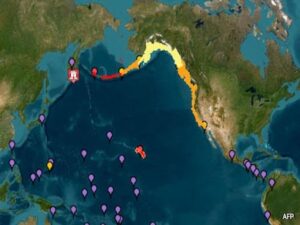GS3 – Disaster Management

Context:
A powerful 8.8 magnitude earthquake struck off Russia’s Kamchatka Peninsula, prompting trans-Pacific tsunami alerts, though with minimal damage reported.
Seismic Details
- Type: A megathrust earthquake, resulting from one tectonic plate being forced beneath another.
- Tectonic Setting: Occurred along the subduction zone where the Pacific Plate dives under the Okhotsk microplate.
- Epicentre: ~130 km southeast of Petropavlovsk-Kamchatsky, in the North Pacific Ocean.
- Rupture Extent: Spanned ~450 km along the Kuril-Kamchatka trench.
- Mechanism: Reverse faulting led to significant vertical displacement of the seafloor.
- Slip Amount: The Pacific Plate shifted around 10 metres.
- Focus Depth: ~21 km deep, intensifying vertical displacement and tsunami generation.
- Plate Characteristics: Cold, rigid subducting slab allowed substantial elastic strain to accumulate before breaking.
- Alerts Issued For: Japan, Hawaii, Philippines, and Pacific coastal regions of the Americas.
Tsunami Generation and Impact
- Cause: Sudden vertical seafloor uplift displaced the overlying water column.
- Global Pattern: Over 80% of tsunamis originate from megathrust subduction events.
- Key Conditions for Tsunamis:
- Magnitude ≥ 6.5
- Shallow hypocentre (<70 km)
- Vertical seabed displacement
- Extensive rupture zone
- High slab rigidity
Why the Tsunami Was Not Catastrophic
Despite the large earthquake, the tsunami’s intensity was limited due to:
- Shallow continental shelf: Slowed wave amplification near the coast.
- Trench geometry: Narrow trench limited uplift and wave spread.
- Segmented rupture: Energy was spread out across fault sections.
- Offshore displacement: Maximum seafloor movement occurred far from the shore.
- No submarine landslide: Prevented additional water displacement.
Kamchatka Peninsula
- Location: Russian Far East, between the Sea of Okhotsk and the Pacific Ocean.
- Tectonic Zone: Lies within the Pacific Ring of Fire, marked by frequent seismic and volcanic activity.
- Volcanism: Contains ~150 volcanoes, including Klyuchevskoy, the tallest active volcano in Eurasia.
- Mountain Ranges: Flanked by the Sredinny and Vostochny ranges.
- Geothermal Significance: Among the world’s most active geothermal zones.
- Biodiversity & Climate: Sub-Arctic tundra with unique flora like mosses and lichens.
- Indigenous Communities: Inhabited by tribes such as Koryaks, Chukchis, and Kamchadals.
- UNESCO Status: The Volcanoes of Kamchatka are recognized as a World Heritage Site.
- Geopolitical Note: Adjacent to the Kuril Islands, which are a point of dispute between Russia and Japan.




